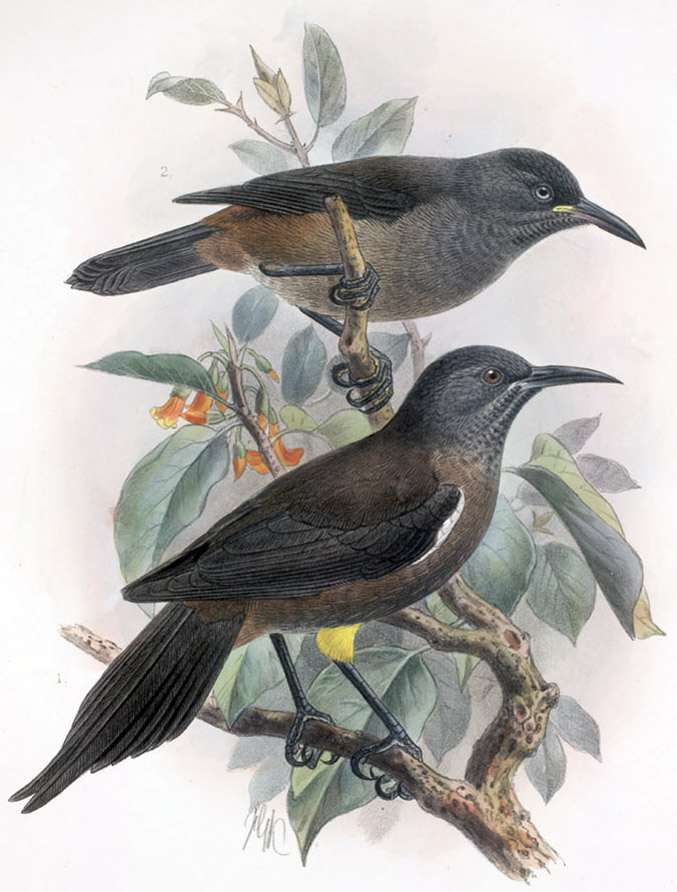Like many of you, we mourned the loss of the last male northern white rhino on Earth. His name was Sudan. Though he was named for the country where he was born, Sudan had spent most of his life in a zoo in the Czech Republic. While Sudan lived out his life thousands of miles from where he was captured in Africa, habitat loss, poaching, and other destructive forces caused the population of northern white rhinos plummeted in their natural habitat. By the early 1980s only a few dozen remained. By 2008, they were thought to be extinct in the wild. Sudan and two females, the last three of their kind on the planet—all of whom had spent their lives in zoos—were living under the protection of armed guards in a wildlife park in Kenya. With the death of Sudan, the only hope for the northern white rhino is through technological fertilization using his cells and those of the remaining females.
There are similarly moving stories in the bird world. During our time at the Cornell Lab of Ornithology we listened to the 1987 recording of a male Kaua‘i ‘o‘o (a honeycreeper). His voice echoed hauntingly across the highlands of the Hawaiian Island of Kaua’i as he sang his unique and beautiful song to attract a mate that would never respond because there were no longer any left—this bird was the last of his kind. Heartbreaking, especially knowing that the extinction was, as is often the case, caused by humans: introduction of the Polynesian rat, domestic pig, and mosquitoes carrying avian malaria and other bird diseased, as well as habitat destruction.

Kaua‘i ‘o‘o
Even Maine has lost its share of species. In the late 1800s, hundreds of Eskimo Curlews were sometimes seen in August and September in open barrens on coastal islands, headlands, and in fields in southern Maine. Ralph Palmer, in his 1949 seminal book, “Maine Birds,” recounts diary entries and letters from the 1870s describing thousands alighting in fields in North Yarmouth, South Portland, and Scarborough. After some detective work, Palmer also discovered that some of the last Eskimo curlews on the planet may have been four shot illegally at Schoodic Point on August 28, 1929.
And did you know Maine once was home to caribou? The species’ legacy lives on in the various “caribou” names of mountains, bogs, and streams—and, of course, the Aroostook Country town of Caribou. The last caribou in Maine disappeared around 1914. Several attempts at introducing Newfoundland caribou to the state have been unsuccessful.
But in all the sadness in that comes from stories like these, we must remember that we humans have the capacity to do what it takes to make things better, and in many cases, we have.
The rebounding of populations of Common Eiders, Wood Ducks, terns, herons, and egrets came in response to passage of the Migratory Bird Treaty Act, the 100-year anniversary that we are now celebrating this year, the Year of the Bird.
We should take heart and remember that Ospreys, Bald Eagles, and Peregrine Falcons are thriving today after the DDT era as a result of the formation of the Environmental Protection Agency and the passage of the historic Endangered Species Act (ESA). Let’s not forget that Piping Plover populations tripled in size over the last three decades as efforts went into their protection in part because of the ESA as well as state-level protections and funding.
It may be hard for some to believe now, but wild turkeys were completely gone from Maine at one time. Reintroduction and management to bring them back to the abundance that we now see is a result of funding to Maine’s state fish and wildlife agency.
While stories of the loss of Sudan and the potential extinction of the northern white rhino evolutionary lineage are deeply disturbing, such a fate is not predetermined. In the Year of the Bird, we encourage you to make a special effort and take action today to be part of solution that maintains our natural heritage and a healthy environment for ourselves, our children and grandchildren, and for generations to come.
The year 2018 marked the 100-year anniversary of the signing of the Migratory Bird Treaty Act (MBTA). It’s because of this treaty that many bird species—including some for which Maine is well known—are still with us rather than disappearing from the earth forever. In honor of this anniversary, the Natural Resources Council of Maine, along with a large coalition of other groups including the National Geographic Society, Birdlife International, the National Audubon Society, the Cornell Lab of Ornithology, and others declared 2018 to be the Year of the Bird. In celebration of this conservation success story, and to put the spotlight on the importance of initiatives such as these, birders Jeff and Allison Wells posted each month in 2018, the “Year of the Bird.”











Leave a Reply